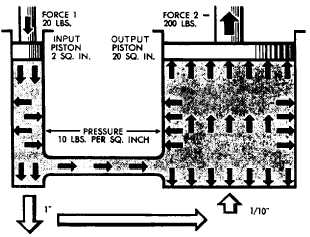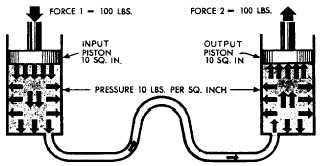is provided by the equipment to which the
output piston is attached. The force of re-
sistance acts against the top of the output
piston. The pressure created in the system
by the input piston pushes on the underside of
the output piston with a force of 10 pounds on
each square inch.
In this case, the fluid column has a uniform
cross section, so the area of the output piston
is the same as the area of the input piston,
or 10 square inches. Therefore, the upward
force on the output piston is 100 pounds
(10 psi x 10 sq. in.), the same as the force applied
to the input piston. All that was accomplished in
this system was to transmit the 100-pound force
around the bend. However, this principle under-
lies practically all mechanical applications of fluid
power.
At this point you should note that since
Pascal’s law is independent of the shape of
the container, it is not necessary that the
tube connecting the two pistons have the same
cross-sectional area of the pistons. A connection
of any size, shape, or length will do, as long as
an unobstructed passage is provided. Therefore,
the system shown in figure 2-10, with a relatively
small, bent pipe connecting two cylinders,
will act exactly the same as the system shown in
figure 2-9.
MULTIPLICATION OF FORCES.— Con-
sider the situation in figure 2-11, where the input
piston is much smaller than the output piston.
Assume that the area of the input piston is 2
square inches. With a resistant force on the output
piston a downward force of 20 pounds acting on
the input piston creates a pressure of
or 10 psi
Figure 2-10.—Transmitting force through a small pipe.
Figure 2-11.—Multiplication of forces.
in the fluid. Although this force is much smaller
than the force applied in figures 2-9 and 2-10, the
pressure is the same. This is because the force is
applied to a smaller area.
This pressure of 10 psi acts on all parts of the
fluid container, including the bottom of the
output piston. The upward force on the output
piston is 200 pounds (10 pounds of pressure on
each square inch). In this case, the original force
has been multiplied tenfold while using the same
pressure in the fluid as before. In any system with
these dimensions, the ratio of output force to
input force is always ten to one, regardless of the
applied force. For example, if the applied force
of the input piston is 50 pounds, the pressure in
the system will be 25 psi. This will support a
resistant force of 500 pounds on the output piston.
The system works the same in reverse. If we
change the applied force and place a 200-pound
force on the output piston (fig. 2-11), making it
the input piston, the output force on the input
piston will be one-tenth the input force, or 20
pounds. (Sometimes such results are desired.)
Therefore, if two pistons are used in a fluid power
system, the force acting on each piston is directly
proportional to its area, and the magnitude of
each force is the product of the pressure and the
area of each piston.
Note the white arrows at the bottom of figure
2-11 that indicate up and down movement. The
movement they represent will be explained later
in the discussion of volume and distance factors.
2-7




